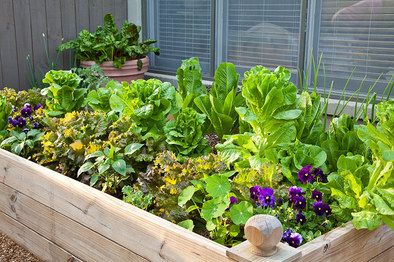 Think you have to live on a farm to grow vegetables? Think again. People in rural, suburban, and even urban areas with small landscapes, have success in growing vegetables in raised garden beds. Some of the best tomatoes I've had are from a friend's very small garden on a main street in Brockton. Raised-bed gardening is a great way to grow vegetables. It does not require much space and can be incorporated into your existing landscape easily. A raised garden bed works well even if your ground soil is undesirable or has poor drainage, and there's less bending over to weed or harvest vegetables. Drainage in a raised bed is superior to that in an in-ground garden bed. The soil in raised beds warms up more quickly in spring so planting can be done earlier. A 12"-deep bed provides ample room for most vegetable roots. Two exceptions are potatoes and corn. Potatoes require a lot of room for their roots and corn can grow so high that harvesting would be difficult. If your raised bed is narrow (maybe 3 - 4 feet maximum), there’s no need to step on the soil to reach all of your veggies. This helps prevent compaction. It's much easier for roots to grow in loose soil. A raised garden bed can be built directly over grass, dirt or even a concrete patio. Don't build a raised bed on a wooden deck: when it’s full of soil and water, the weight could cause structural damage to the deck. If the raised bed sits directly on soil, line the planting bed with chicken wire when installing the bed to keep burrowing animals at bay. The bed may be made of wood, stone, brick, metal, or any other material. If you want to go with wood, redwood or cedar are attractive and resist rot. Choose a spot in your existing landscape that you can reach with your hose and gets at least six hours of sun a day. Here’s a great how-to for building and installing a raised bed vegetable garden yourself. Good luck!
0 Comments
|
Archives
February 2024
AuthorRodrigo Dos Anjos Categories
All
|
Gardenin' Angels, Landscape Management & Construction
A preferred landscaper, serving Southeastern Massachusetts
11 Renker Drive, Easton, MA 02375
774-284-1171
[email protected]
Privacy Policy • Terms of Use

 RSS Feed
RSS Feed